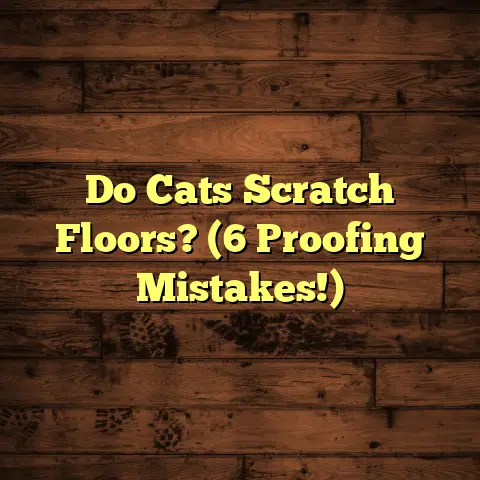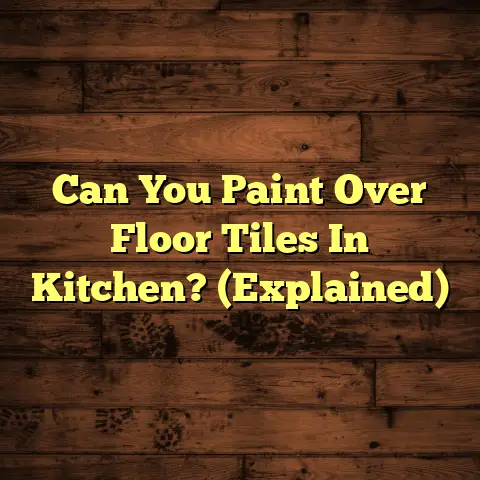Concrete Floor Sealers: Which Type? (6 Options)
As a flooring contractor for over 15 years,
I’ve seen countless homeowners wrestle with
this.
The trick?
Finding value.
And when it comes to concrete floors, that value starts with the right sealer.
Trust me, choosing wisely can save you
money, headaches, and a whole lot of scrubbing
in the long run.
Let’s dive in!
Understanding Concrete Floors
Concrete floors?
They’re not just for garages
anymore!
We’re seeing them everywhere –
modern homes, trendy restaurants, even
upscale boutiques.
Why?
They’re durable as heck, easy to clean
(usually!), and surprisingly versatile when it
comes to style.
Think polished concrete with
a cool, industrial vibe, or stained concrete
that mimics natural stone.
But here’s the thing: concrete is porous.
Think of it like a sponge.
Without protection,
it’ll soak up spills, stains, and moisture like
crazy.
That’s where sealing comes in.
Sealing basically creates a protective barrier that keeps the bad stuff out and helps your floor look its best for years to come.
The Importance of Concrete Floor Sealers
So, why bother sealing your concrete floor? Let me break it down.
First off, appearance.
A good sealer can
enhance the natural beauty of your concrete,
bringing out its color and texture.
It can also
add a glossy or matte finish, depending on
your preference.
Then there’s water damage.
Concrete is
porous, remember?
Water can seep in, leading
to cracks, spalling (that’s when the surface
starts to flake off), and even mold growth.
A sealer acts like a raincoat, keeping water out and protecting your floor from the elements.
And let’s not forget about stains.
Red wine,
oil, grease – these are all concrete’s worst
enemies.
A sealer creates a barrier that
prevents these substances from penetrating
the surface, making cleanup a breeze.
But here’s the real kicker: longevity.
By
protecting your floor from water damage, stains,
and wear, a sealer can significantly extend
its lifespan.
This means fewer repairs, fewer
replacements, and ultimately, more money in
your pocket.
Think of it this way: spending a few hundred
dollars on a good sealer now can save you
thousands in repairs down the road.
That’s
value, my friend.
Types of Concrete Floor Sealers
Alright, let’s get down to the nitty-gritty.
There are a ton of different concrete floor
sealers out there, but I’m going to focus on
the six most common types I use.
1. Acrylic Sealers
Description: Acrylic sealers are basically
film-forming coatings made from acrylic resins.
They’re easy to apply with a roller or sprayer
and dry relatively quickly.
Benefits: The biggest selling point of
acrylic sealers is their affordability.
They’re
generally the cheapest option on the market.
They also provide a decent level of protection
against stains and wear, and they can add a
nice glossy finish to your floor.
Drawbacks: Acrylic sealers aren’t the most
durable option out there.
They tend to wear
down quickly, especially in high-traffic areas.
They’re also susceptible to UV damage, which
can cause them to yellow or crack over time.
I’ve also noticed they are more prone to
scratching compared to other sealers.
2. Epoxy Sealers
Description: Epoxy sealers are two-part
systems that consist of a resin and a hardener.
When mixed together, these components create
a chemical reaction that results in a super-hard,
durable coating.
Benefits: Epoxy sealers are incredibly
tough and resistant to chemicals, abrasion, and
impact.
They’re a great choice for garages,
workshops, and other areas that see heavy use.
They also create a beautiful, high-gloss finish
that can really enhance the look of your floor.
Drawbacks: Epoxy sealers can be tricky
to install.
Proper surface preparation is
essential, and the mixing and application process
can be a bit complicated.
They also tend to
be more expensive than acrylic sealers.
Plus, once applied, they can be difficult to
remove if you decide you don’t like them.
3. Polyurethane Sealers
Description: Polyurethane sealers are
another type of film-forming coating that
provides excellent durability and protection.
They’re often used as a topcoat over epoxy
sealers to enhance their scratch resistance and
UV stability.
Benefits: Polyurethane sealers are known
for their exceptional durability and scratch
resistance.
They’re also highly resistant to
UV damage, which means they won’t yellow or
fade over time.
This makes them a great choice
for outdoor applications.
Drawbacks: Polyurethane sealers can take
longer to cure than other types of sealers.
They also tend to be more expensive than
acrylic sealers.
And while they’re resistant
to UV damage, some formulations can still
yellow slightly over time.
4. Silane/Siloxane Sealers
Description: Silane and siloxane sealers are
penetrating sealers that work by chemically
reacting with the concrete to create a water-
repellent surface.
They don’t form a film on
top of the concrete, so they don’t change its
appearance.
Benefits: The main benefit of silane/
siloxane sealers is their ability to penetrate
deep into the concrete and provide excellent
water repellency.
This helps prevent water
damage, freeze-thaw damage, and efflorescence
(that white, powdery stuff that sometimes
appears on concrete surfaces).
Drawbacks: Silane/siloxane sealers don’t
enhance the appearance of concrete.
They
won’t add any gloss or color, so they’re not
a good choice if you’re looking to improve
the aesthetic of your floor.
They also don’t
provide much protection against stains or
abrasion.
5. Penetrating Sealers
Description: Penetrating sealers are similar
to silane/siloxane sealers in that they penetrate
the concrete and don’t form a film on the surface.
However, they typically use different chemicals
to achieve their water-repellent properties.
Benefits: Penetrating sealers provide deep,
long-lasting protection against water damage
without altering the appearance of the concrete.
They’re a good choice for applications where
you want to maintain the natural look of the
concrete while still providing protection.
Drawbacks: Penetrating sealers can be
difficult to reapply, as they can sometimes
prevent other sealers from penetrating the
concrete.
They also may not be as effective
over time as other types of sealers, especially
in high-traffic areas.
6. Film-Forming Sealers
Description: Film-forming sealers create a
protective layer on top of the concrete surface.
These sealers can be acrylic, epoxy, or
polyurethane-based, and they come in a variety
of finishes, from matte to high-gloss.
Benefits: Film-forming sealers can enhance
the appearance of concrete by adding color,
gloss, or texture.
They also provide a strong
barrier against stains, abrasion, and chemicals.
Drawbacks: Film-forming sealers are
susceptible to peeling, especially if the
concrete surface isn’t properly prepared.
They
also require regular maintenance to avoid
surface damage and maintain their appearance.
Comparing the Six Options
Okay, so that’s a lot of information to take in.
To make things easier, here’s a table that
summarizes the key differences between the six
types of concrete floor sealers:
Now, let’s talk about scenarios.
-
Budget-conscious homeowner? Acrylic sealer might be your best bet.
-
Garage floor that takes a beating? Go with epoxy.
-
Outdoor patio in a sunny climate? Polyurethane is the way to go.
-
Want to protect your concrete without changing its look? Silane/siloxane or penetrating sealer is your friend.
-
Looking to add a pop of color or a high-gloss finish? Film-forming sealer could be perfect.
Application Techniques and Best Practices
Alright, so you’ve chosen your sealer.
Now
what?
Here’s a quick rundown of application
techniques and best practices.
Preparation is key! No matter what type
of sealer you’re using, proper surface
preparation is essential.
This means cleaning
the concrete thoroughly to remove any dirt,
grease, or existing coatings.
You may also
need to etch the concrete to open up the pores
and allow the sealer to penetrate properly.
Follow the manufacturer’s instructions.
Every sealer is different, so it’s important
to read and follow the manufacturer’s
instructions carefully.
This will ensure that
you apply the sealer correctly and achieve
the best possible results.
Use the right tools. For most sealers, you’ll
need a roller, brush, or sprayer.
Make sure
you choose the right tool for the job and use
high-quality applicators to avoid streaks or
uneven coverage.
Apply thin, even coats. It’s better to
apply multiple thin coats of sealer than one
thick coat.
This will help prevent drips, runs,
and bubbles.
Allow the sealer to cure properly. Most
sealers require a certain amount of time to
cure before they can be exposed to traffic or
moisture.
Be patient and allow the sealer to
cure fully before using the floor.
Safety first! Always wear appropriate
safety gear, such as gloves, eye protection,
and a respirator, when applying concrete
sealers.
Work in a well-ventilated area to
avoid inhaling harmful fumes.
Maintenance is key. Once your concrete
floor is sealed, it’s important to maintain
it properly to ensure long-lasting results.
This means cleaning the floor regularly with
a mild detergent and avoiding harsh chemicals
or abrasive cleaners.
You may also need to
reapply the sealer every few years, depending
on the type of sealer you used and the amount
of traffic the floor receives.
Conclusion
Choosing the right concrete floor sealer is a
big decision.
But with a little research and
planning, you can find the perfect sealer to
protect your floor and enhance its beauty for
years to come.
Remember to consider your specific needs,
budget, and desired aesthetic when making
your choice.
And don’t be afraid to ask for
help from a professional if you’re feeling
overwhelmed.
Investing in a quality sealer is an investment
in the long-term value of your home.
It’s a
decision you won’t regret.
So, go forth and seal!
Your floors (and your
wallet) will thank you for it.





